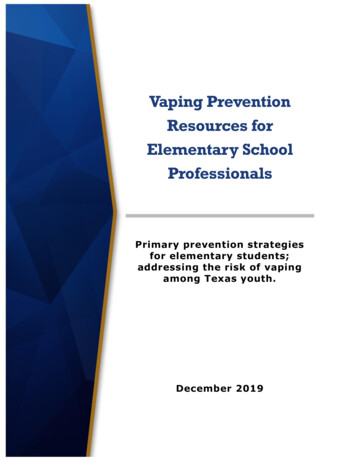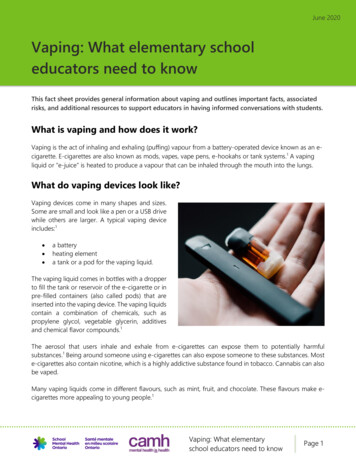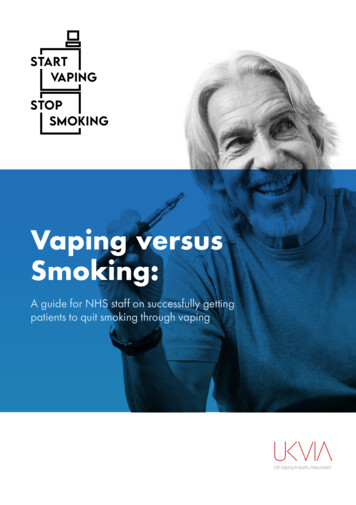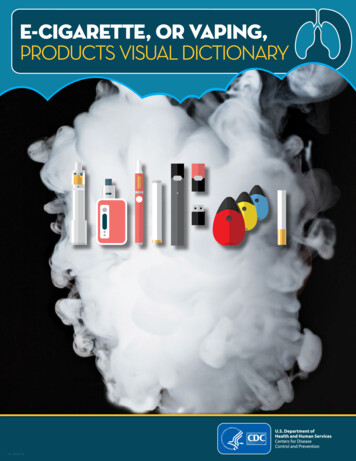
Transcription
Vaping PreventionResources forElementary SchoolProfessionalsPrimary prevention strategiesfor elementary students;addressing the risk of vapingamong Texas youth.December 2019
ContentsContents . 11. Overview: . 2WHAT IS THE ISSUE?.2WHAT CAN EDUCATORS DO? .22. TEXAS ESSENTIAL KNOWLEDGE AND SKILLS (TEKS). 3Kindergarten .3Grade 1 .3Grade 2 .3Grade 3 .3Grade 4 .3Grade 5 .33. IDENTIFYING RISK FACTORS . 4RISK FACTORS .44. ACTIVITY: CHANGING NORMS . 55. RESOURCES . 6TEXAS RESOURCES .6NATIONAL RESOURCES .6CURRICULUMS .76. Citations . 81
1. Overview:WHAT IS THE ISSUE? Tobacco use, especially e-cigarette use, among youth is alarmingly high.Data from the 2019 National Youth Tobacco Survey show that 12.5% ofmiddle school students are using some type of tobacco product. The samedata shows that 10.5% of middle schoolers reported current, past 30 day,use of e-cigarettes.1E-cigarettes are not safe for youth.2Youth who use e-cigarettes are more likely to begin using combustibletobacco products than their peers that do not use e-cigarettes.3Nicotine is highly addictive and can harm childhood and adolescent braindevelopment, which continues until about age 25, negatively impactingmemory, learning, and attention.2WHAT CAN EDUCATORS DO? Adapt existing prevention resources for middle and high school youth to beused for prevention and awareness in elementary schools.Provide take-home information on vaping for students to give to theirparents.4Reject youth tobacco prevention programs sponsored by the tobaccoindustry. These programs have been found to be ineffective for preventingyouth tobacco use.52
2. TEXAS ESSENTIAL KNOWLEDGE AND SKILLS (TEKS)The TEKS for Health Education outline the health information andskills that should be taught to Texas youth. Educators can use TEKSas a framework to integrate tobacco prevention resources andmessaging in the classroom setting.Kindergarten, students are taught toname the harmful effects of tobacco,alcohol, and other drugs. This lesson isreinforced yearly.Grade 1, students are taught to identifyexamples of health information providedby various media and cite examples ofhow media and technology can affectbehaviors such as television, computers,and video games.Grade 2, students are taught to explainthe importance of avoiding dangeroussubstances and to describe strategiesfor protecting the environment and therelationship between the environmentand individual health such as airpollution. As well, to describe howfriends can influence a person’s healthand to explain steps in the decisionmaking process and the importance offollowing the steps.Grade 3, students are taught todescribe the importance of takingpersonal responsibility for reducinghazards including the role of nosmoking laws. Also, to distinguishbetween positive and negative peerpressures and their effects on personalhealth behaviors; and to practicecritical-thinking skills when makinghealth decisions. As well, to explain thepositive and negative consequences ofmaking a health-related choice and topractice assertive communication andrefusal skills.Grade 4, students are taught todescribe the short-term and long-termharmful effects of tobacco, alcohol, andother substances such as physical,mental, social, and legal consequences;identify ways to avoid drugs and listalternatives for the use of drugs andother substances. Also, to explain howthe media can influence healthbehaviors; and describe waystechnology can influence health.Students are also taught to explain theinfluence of peer pressure on anindividual’s social and emotional health;and to be a positive role model forhealth.Grade 5, students are taught toresearch the effect of media on healthpromotion behaviors.Chapter 115. Texas Essential Knowledgeand Skills for Health EducationSubchapter A. Elementary.3
3. IDENTIFYING RISK FACTORSA risk-focused approach has been used to effectively change youthbehavior; the same framework can be applied to the prevention oftobacco products, including e-cigarettes and other vaping products.This approach requires the identification of risk factors for vaping,identification of methods by which risk factors have been effectivelyaddressed, and application of these methods to appropriate high-riskand general population.6Some possible risk factors that may promote vaping among elementary studentsinclude physical harm (poisoning from e-liquid exposure), exposure to e-cigarettemarketing (digital, print, or social media), environmental (lack of tobacco-freeindoor air law), peers (social norms or influence), parent/guardian (use andperception). All of these risk factors should be addressed during childhooddevelopment to reduce the likelihood that a child will begin vaping.RISK FACTORSGRADE ADDRESSED IN TEKSK12345 Environmental Peer Norms/Influence Physical HarmMarketing Parent/Guardian Use & Perception Resources to address each risk factor can be found in the links on Page 6.4
4. ACTIVITY: CHANGING NORMSVaping behavior can be motivated by peer influence, specifically bypeers that are viewed as opinion leaders in youth social circles. Theyoung person that may be most susceptible to peer influence can bedescribed as easily motivated to act for increased perceived socialvalue.7Changing social norms can be as simple as providing information about the actualprevalence of a behavior. Often, the misperception is that “everyone is doing it”when in fact a small minority of a demographic is engaging in the undesiredbehavior. In 2019, 10.5% of middle school students reported vaping3, this isalarming for public health but also means that 89.5% or almost 9 out of 10students are not vaping; increasing awareness of the actual number of youth notvaping could change perception and social norms.Schools can change norms by dispelling misperceptions about the prevalence ofvaping among youth. Create a poster campaign promoting the positive fact thatalmost 9 out of 10 students are NOT using an e-cigarette or vape product andencourage students to ‘be a part of the majority’ of students that are not usingtobacco products.Find more examples of activities at: http://txsaywhat.com/5
5. RESOURCESTEXAS RESOURCESDepartment of State Health Services - https://www.dshs.texas.gov/tobacco/ECigarettes/Say What! - http://txsaywhat.com/Tobacco-Free School Signage 83a61185c2bbacdNATIONAL RESOURCESAmerican Association of Poison Control Centers neAmerican Lung Association – e-cigarettes-schools.pdfCampaign for Tobacco Free Kids 0382.pdfCDC - https://www.cdc.gov/tobacco/basic information/ecigarettes/factsheet/index.htmlFDA Tobacco - https://www.fda.gov/tobacco-productsMaryland Department of Health blic Health Law Center fTruth Initiative – ic/emergingtobacco-products?subtopic%5B68%5D 686
US Surgeon General - 016 SGR Fact Sheet 508.pdfCURRICULUMSCATCH my breath: E-cigarette & Juul Prevention Program : An Alternative to Teen Nicotine Suspension or Citation, AmericanLung Association - t/indepth.htmlMD Anderson ASPIRE - ity-services/aspire.htmlReal Cost of Vaping: Scholastic and FDA Grades 6-12 d Tobacco Prevention Toolkit tml7
6. CitationsCullen, KA, et al., “e-Cigarette Use Among Youth in the United States, 2019” JAMA,published online November 5, 2019.2U.S. Department of Health and Human Services, E-Cigarette Use Among Youth and YoungAdults. A Report of the Surgeon General. 2016, U. S. Department of Health and HumanServices, Centers for Disease Control and Prevention, National Center for Chronic DiseasePrevention and Health Promotion, Office on Smoking and Health: Atlanta, GA.3Leventhal AM, Strong DR, Kirkpatrick MG, et al. (2015). Association of Electronic CigaretteUse With Initiation of Combustible Tobacco Product Smoking in EarlyAdolescence. JAMA.314(7):700–707. doi:10.1001/jama.2015.89504Kristjansson, A. L., Allegrante, J. P., & Sigfusdottir, I. D. (2018). Perceived parentalreactions to substance use among adolescent vapers compared with tobacco smokers andnon-users in Iceland. Public health, 164, 115-117.5Landman, A., Ling, P. M., & Glantz, S. A. (2002). Tobacco industry youth smokingprevention programs: protecting the industry and hurting tobacco control. American journalof public health, 92(6), 917-930.6Hawkins, J. D., Catalano, R. F., & Miller, J. Y. (1992). Risk and protective factors foralcohol and other drug problems in adolescence and early adulthood: implications forsubstance abuse prevention. Psychological bulletin, 112(1), 64.7Yule, J. A., & Tinson, J. S. (2017). Youth and the sociability of “Vaping”. Journal ofConsumer Behaviour, 16(1), 3-14.18
marketing (digital, print, or social media), environmental (lack of tobacco-free indoor air law), peers (social norms or influence), parent/guardian (use and perception). All of these risk factors should be addressed during childhood development to reduce the likelihood that a child will begin vaping. RISK FACTORS GRADE ADDRESSED IN TEKS










